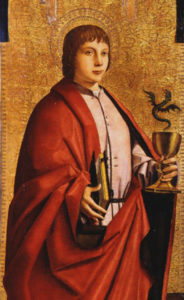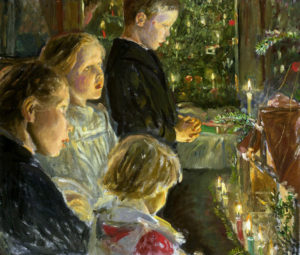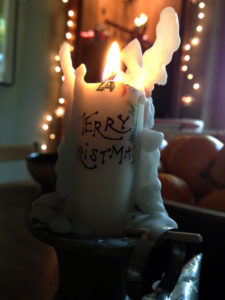
SECOND DAY of CHRISTMAS:
St. John’s Day
St. John the Evangelist was the only one of Christ’s disciples who did not meet a violent death for his beliefs. While his counterparts were martyred off, one by one, John lived to be an old man. Not that no one tried to get rid of him. No, John the Evangelist had many attempts on his life. The most famous failed attempt is what gives us our tradition for today, the Second Day of Christmas. The story goes that St. John drank wine that was deliberately poisoned and meant to kill him… but it had no effect on the man. And so on his feast day, which happens to be this Second Day of Christmas, it is traditional to bless our wine. In Europe especially, it is traditional to bring wine to church in order for the priest to bless it. This blessed wine is reserved through the year and given as a healing tonic to those who are ill. The blessed St. John’s wine is also thought by many to have a better flavor. And no need to bring all your stores of wine to the church for a blessing; blessed St. John’s wine is said to even impart better flavor on wine that is stored in its vicinity. That’s some powerful stuff.
Whether you have your wine blessed today at church or not, one thing is clear in the spirit of this merry Christmas season: it is a night for wine. In Italy yesterday for St. Stephen’s Day, folks ate roasted chestnuts and drank mulled wine, and tonight, for St. John’s Day, this festivity of the simple bounty of the earth will continue. The wine in Italy for these nights is typically mulled, and every year for St. John’s Day I give you my recipe for mulled wine. Here it is again: Pour a bottle of good red wine into a stainless steel pot and set it on the stove over medium heat. Add some mulling spices (we sell some wonderful mulling spices at the Convivio Bookworks website that are from the Sabbathday Lake Shaker Community in Maine… they call it Mulled Cider Mix but it’s just as good in wine), and sugar. Start with a teaspoon or two of sugar and add more to taste. We prefer a less-sweet mulled wine, and while you can always add more sugar, you can’t take it away once it’s in. So I recommend adding the sugar gradually, tasting as you go. Heat to allow the spicy flavors to infuse the wine. Strain before serving in cups (not glasses).
Here’s a little something you may find as fascinating as I did when I learnt it just the other day from the folks at Old Sturbridge Village in Massachusetts: It has to do with our common American expression, “Merry Christmas.” We rarely use the word “merry” other than at Christmas, and yet in England, where the idea of a merry Christmas began, the common greeting at this time of year is “Happy Christmas.” Christmas wasn’t a very big deal in America early on, mainly because the Puritans hated Christmas and made it illegal to celebrate the holiday. They were not fond of all the merriment that went along with a traditional populist Christmas celebration, and so they outright banned its observance. It was Charles Dickens and Washington Irving who really saved Christmas in England and America from extinction, and as Dickens’ Christmas tales grew increasingly popular in the States, folks here began following his texts, wishing a Merry Christmas to everyone they met.
In post-Dickens Victorian England, though, another round of anti-merriment clergy were getting their knickers in a bunch. This time it was the Methodists. They began promoting “Happy Christmas” as a more respectable greeting, more high-brow… less merry, less drunken. That took hold in England, and even today, folks there are more likely to wish you a Happy Christmas.
Despite our Puritanical beginnings, “Merry Christmas” reigns here in the States. It is a decidedly secular greeting, less reverential, more festive. On this Second Day of Christmas, we wish you that lovely balance that contains a bit of both. The blessed (or not) wine and chestnuts pave the way: Happy, Merry Christmas.
Image: San Giovanni Evangelista. A detail from a triptych by Antonello da Messina at the Uffizi in Florence. Oil on panel, circa 1470 [Public domain] via Wikimedia Commons.


